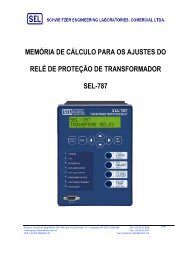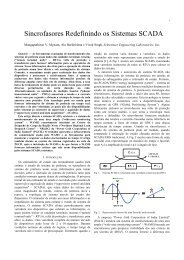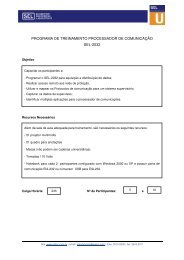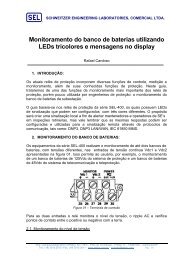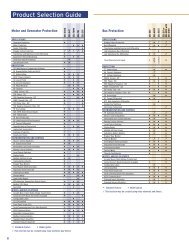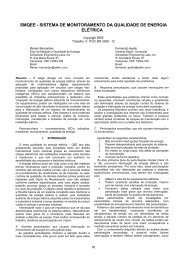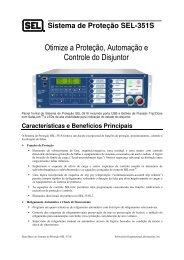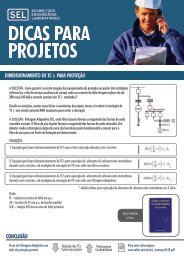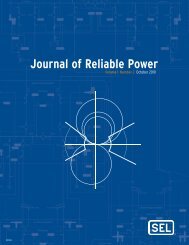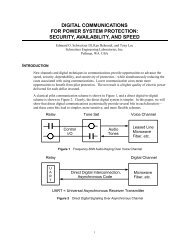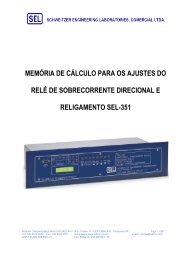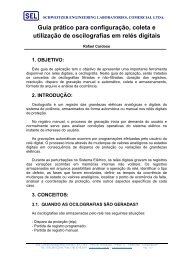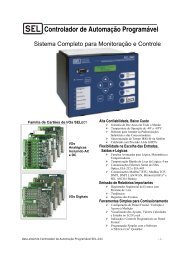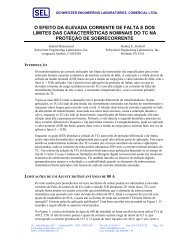Journal of Reliable Power - SEL
Journal of Reliable Power - SEL
Journal of Reliable Power - SEL
Create successful ePaper yourself
Turn your PDF publications into a flip-book with our unique Google optimized e-Paper software.
9<br />
The relay’s directional element can use negative-sequence<br />
voltage polarization (Q), zero-sequence voltage polarization<br />
(V), or current polarization (I) [10]. Only one element can be<br />
used at any one time. The user selected the negative-sequence<br />
element; its torque equation is shown as (2).<br />
32Q = V I cos ∠−V<br />
– ∠I<br />
+ MTA (2)<br />
( ( )<br />
T ∠<br />
2 2<br />
2 2<br />
With the local generation connected, negative-sequence<br />
polarization would have been dependable. However, with the<br />
generation isolated, the negative-sequence polarized element<br />
does not correctly determine the fault direction. This is<br />
because <strong>of</strong> the lack <strong>of</strong> negative-sequence current from the pure<br />
zero-sequence source (wye-grounded transformer) behind the<br />
relay. By replaying the event data into a relay, we prove that<br />
zero-sequence voltage polarization correctly determines this to<br />
be a forward fault. The event data indicate that zero-sequence<br />
current polarization would have also correctly declared a<br />
forward fault for this event; I POL and 3I0 are in phase.<br />
The user can choose to change the polarization quantity.<br />
This decision, however, sacrifices a more reliable directional<br />
element in order to trip faster during a rare operating condition.<br />
A practical improvement would be to wire a 52b contact<br />
from the generator breaker in parallel with the carrier squelch<br />
contact from the relay. This would allow high-speed clearing<br />
from the utility source for faults that occur when the<br />
generation is <strong>of</strong>fline.<br />
The directional elements in newer relays <strong>of</strong>fer the ability to<br />
choose the best choice for the current system configuration<br />
and fault without requiring settings changes [3]. Multiple<br />
elements with different polarizing quantities are processed<br />
simultaneously. One setting allows the user to determine<br />
which polarizing source to use first, second, and third. If the<br />
first-choice element does not have adequate quantities, then<br />
the second choice will be evaluated. If the second choice does<br />
not have adequate signal, then the third and final choice is<br />
evaluated.<br />
Event data were replayed into a newer relay with best<br />
choice ground directional element logic (see Fig. 24). 32VE<br />
is the zero-sequence polarizing enable element, and F32V and<br />
32GF are the forward ground fault directional declaration bits.<br />
32IE is the current polarizing enable element, and F32I and<br />
32GF are the forward ground fault directional declaration bits.<br />
32QGE and 32QE are the negative-sequence element enables,<br />
and 32QF and 32GF are the forward ground fault directional<br />
declaration bits.<br />
In the simulation, we chose an order that always gives<br />
preference to negative-sequence polarization (Q, V, I). In this<br />
case, there is little negative-sequence, so the relay checks<br />
zero-sequence and makes the proper forward directional<br />
declaration. This secure operation comes at the expense <strong>of</strong> a<br />
slight processing delay. Overall, this directional logic results<br />
in faster operating times for all system states. When the<br />
generation is online, the negative-sequence directional element<br />
operates most reliably, and when generation is <strong>of</strong>fline,<br />
the zero-sequence element operates correctly.<br />
IA IB IC<br />
VA(kV) VB(kV) VC(kV)<br />
Digitals<br />
1000<br />
0<br />
-1000<br />
50<br />
0<br />
-50<br />
Fig. 24.<br />
32QF<br />
F32I<br />
32GF<br />
F32V<br />
32GR<br />
R32V<br />
32IE<br />
32VE<br />
32QE<br />
32QGE<br />
IA IB IC VA(kV) VB(kV) VC(kV)<br />
.125 cycles<br />
0.0 2.5 5.0 7.5 10.0 12.5 15.0<br />
Cycles<br />
Best Choice Ground Directional Element Logic for BG Fault<br />
If none <strong>of</strong> the directional element enables (32QGE, 32VE,<br />
and 32IE) assert, then the relay defaults to the negativesequence<br />
element (as long as Q is listed in the order setting).<br />
When the relay defaults in this manner, it also bypasses a ratio<br />
check <strong>of</strong> negative-sequence to zero-sequence. It was this ratio<br />
check, |I2| > k2 • |I0|, that prevented the negative-sequence<br />
element from operating in the simulation.<br />
X. WHEN STANDARD SETTINGS DO NOT WORK<br />
In August 2006, a 230 kV line terminal tripped incorrectly<br />
for a reverse CG fault. The line is a three-terminal DCB<br />
scheme. There is no positive-sequence source behind the<br />
relay, but there are two ground sources—an autotransformer<br />
with a delta tertiary and a wye-grounded high-side, delta lowside<br />
power transformer.<br />
The fault data from the event are shown in Fig. 25. During<br />
the fault, V2 leads I2 by 83 degrees and has a magnitude <strong>of</strong><br />
15 volts secondary. The fault current magnitude is<br />
3700 amperes primary. The forward directional element<br />
(32QF) asserts incorrectly and allows a trip by the directional<br />
ground overcurrent element (67N2dcb).<br />
IA IB IC IRMag<br />
VA VB VC<br />
V2Ang I2Ang<br />
Digitals<br />
2500<br />
0<br />
-2500<br />
100<br />
0<br />
-100<br />
100<br />
0<br />
-100<br />
Fig. 25.<br />
32QF<br />
3PT<br />
67N2pu<br />
67N2dcb<br />
IA IB IC IRMag VA<br />
VB VC V2Ang I2Ang<br />
2 3 4 5 6 7 8 9 10 11<br />
Cycles<br />
Forward Fault Declaration for Reverse CG Fault<br />
60 | <strong>Journal</strong> <strong>of</strong> <strong>Reliable</strong> <strong>Power</strong>



